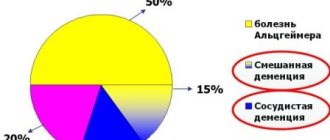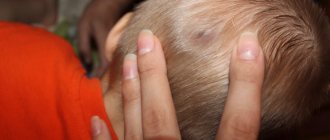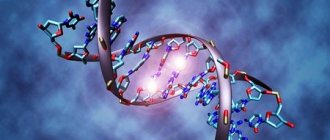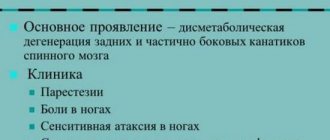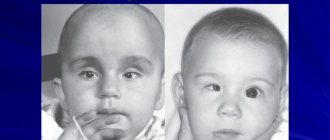What is dementia in a child?
Dementia in children manifests itself in a pathological disorder of brain activity, which is characterized by the loss of previously acquired knowledge and skills, as well as a decrease in interest in the world around them. Dementia is an acquired disease. Diagnosis and treatment of this pathology become possible after the age of two years, as it develops against the background of concomitant diseases and external factors.
Common signs of dementia
Dementia is an acute mental disorder diagnosed in a child and arising in connection with damage to the brain. Dementia entails degradation of intelligence and the disintegration of an already established personality. Currently, dementia is divided into progressive and organic dementia.
Progressive dementia in children is a steady deterioration of the brain. Symptoms of dementia increase as the underlying disease progresses.
Organic dementia is caused by complications of certain diseases that the child has suffered. The organic form of dementia is characterized by stable abnormalities in brain function, which do not worsen in the future. This type of disease is often caused by drug poisoning, meningitis and head injuries.
Sometimes dementia is confused with oligophrenia, which appears against the background of injuries and infections. However, these diseases differ in that with dementia there is a partial disruption of formed mental functions, and oligophrenia affects the entire mental activity of the child.
Common signs of dementia include the following:
Deviations in mental activity;
Loss of critical thinking;
Problems with speech, including a decrease in vocabulary, the inability to remember the meaning of a particular word;
Absent-mindedness, decreased concentration;
Auditory and visual pathologies;
Anxiety, unreasonable fear, depression, indifference, apathy, sudden mood swings and other deviations of an emotional nature;
Weakening of the instinct of self-preservation;
Inadequate reaction to certain events;
Problems with self-care;
Loss of previously acquired skills and abilities;
Declining communication abilities.
Symptoms of dementia in children
Symptoms of dementia in children vary depending on age. If a child suffered cerebral lesions and suffered damage to his health during his school years, there is a noticeable contrast between the level of development of skills, erudition and ability to learn new information. He speaks well, constructs sentences correctly, and has a sufficient vocabulary. In the process of communication, a child with dementia is dominated by specific situational thinking: he can describe in detail the events he experienced, which he will evaluate from the point of view of practical actions and results.
Along with this, a child with dementia has virtually no perception of abstract concepts. He does not understand the figurative meaning of sayings and proverbs, does not perceive humor, and does not know how to transfer the specific experience he has experienced to another situation. The child cannot effectively apply previously acquired knowledge. He remembers new information poorly, often switches his attention from one subject to another, and quickly becomes emotionally exhausted. Personality and affective deviations begin to develop. Emotions in children with dementia become poorer and flattened, losing their nuances. Severe forms of dementia in children are characterized by a predominance of pronounced states - from happiness to obvious displeasure. The child’s interests are narrowed so much that he is only concerned about meeting basic needs.
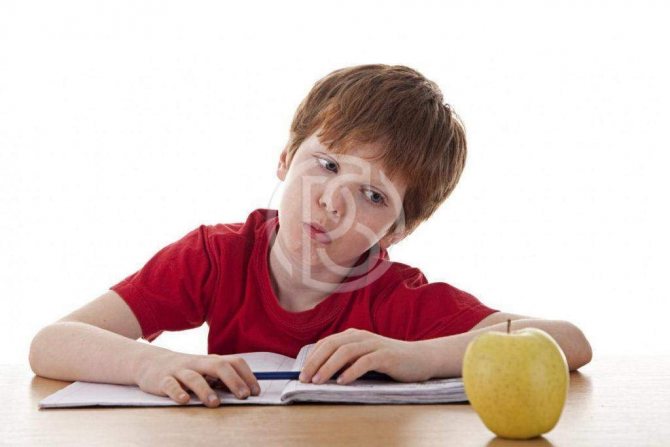
Symptoms of dementia in younger children are somewhat different. The main ones are psychomotor agitation, an unreasonable change of state, when anger and crying alternate with joy and pleasure. A child with dementia becomes much less emotional, stops missing his mother, does not respond to blame or praise, and does not show affection for anyone. With dementia in children, elementary drives intensify and an excessive appetite develops. The disease entails a weakening of the instinct of self-preservation: such a child does not show anxiety when changing the environment, is not afraid of fire, heights, etc.
During the course of the disease, cognitive functions are completely destroyed. A child can repeat the same thing over and over again without realizing it; his reasoning is random and superficial. He does not assimilate new information at all and loses the ability to use previously accumulated life experience. Other obvious symptoms of dementia are a lack of abstract thinking, intellectual deficits, disorganization and decreased concentration. The child's games are becoming more and more simple; he can run aimlessly back and forth, roll on the floor, throw toys and various objects. At the same time, he does not accept any rules, continuing to mindlessly do what he wants.
Classification of types of disease
Dementia in children can be infectious, intoxicating, or have another etiological cause. Dementia is also classified according to the severity of the pathology:
Mild dementia. It is characterized by smoothness of symptoms and preservation of everyday skills, so detecting the disease, especially in preschool age, is often difficult. Schoolchildren begin to learn the educational material poorly, and their social activity is reduced.
Moderate dementia. At this stage of dementia, the child needs special health care from parents and doctors.
Severe dementia. Speech is impaired, personal characteristics are reduced to the limit. The child requires treatment and constant supervision, as he completely loses self-care skills.
Causes of dementia in children
The development of dementia in a child is associated with the influence on his health of various external factors that disrupt the functioning of the brain. Sometimes the disease is already present at the time of birth, but it develops only after a certain time.
We list the main reasons that can cause dementia:
Genetic diseases that are detected at least two to three years after the birth of the child. These include Lafora and Newman-Pick diseases, Sanfilippo syndrome, etc.
Infectious diseases that directly affect brain function, such as encephalitis or meningitis.
Traumatic brain injuries, concussions.
Intoxication with medications, heavy metals. In adolescents, the disease can be caused by drug and alcohol intoxication.
Problems with blood flow in the vessels, which cause poor nutrition of brain tissue.
There are other reasons associated with pathologies and diseases that can serve as a catalyst for the development of dementia in children. The doctor can tell you more about them after a thorough examination of the patient.
Does dementia occur in children?
Dementia in children and young people is an acquired dementia, which is accompanied by the loss of already developed intelligence. With this disease, brain tissue is damaged, as a result of which memory, speech, analytical and cognitive abilities, and motor skills are impaired.
It is customary to talk about acquired dementia in children when the child reaches 2-3 years of age, when behavior can reveal noticeable deviations from normal mental development.
Overt, progressive dementia is most often observed in children after 15 years of age, when the biological maturation of the brain ends.
Causes of dementia in children
About 70% of all cases of acquired dementia are due to Alzheimer's disease, which primarily affects older people over 65 years of age. For this reason, dementia in young people is rare and is mainly due to hereditary factors.
Gene mutations in chromosomes provoke increased production of abnormal amyloid plaques, which affect nerve cells and destroy established interneuron synoptic connections.
Degradation of brain activity in people under 40 years of age can also occur as a result of mechanical head injuries, drug, alcohol or radiation intoxication, as a complication of chronic cardiovascular pathology.
Childhood organic dementia is usually a complication of some serious diseases. Secondary residual dementia occurs with stable residual disorders of the brain, without further deterioration of the patient's condition. Main causes of dementia in children and older people Causes of dementia in children Causes of dementia in adults
|
|
Hereditary degenerative dementia in children develops against the background of such genetic diseases as Newman-Pick, Batten, Huntington or Lafora disease, Rett and Sanfilippo syndrome, leukodystrophy.
Hereditary forms of dementia progress rapidly as children grow and the clinical manifestations of the underlying genetic disease manifest.
An intense increase in symptoms can lead to death already in adolescence.
Important. Organic dementia in children, and especially in adolescents, is often aggravated by psychological trauma. The obvious loss of acquired skills has a painful impact on the child’s emotional state and can deprive him of his motivation for rehabilitation.
Symptoms of dementia in children
The clinical picture of the disease in children largely depends on the age of the victim. The sooner the process of degradation of the central nervous system begins, the more pronounced the symptoms of dementia in young people will be.
Until the age of 3, the most pronounced signs of dementia are a decrease in motor activity, sometimes the baby even stops walking and crawling.
At the same time, involuntary disinhibition appears, which is accompanied by sudden, jerking movements.
Such children are characterized by excessive capriciousness, increased excitability, instability of emotions with a transition from hysterics and crying to an unreasonable burst of joy.
Characteristics of children with dementia by age group include the following:
- in preschoolers - impulsive, disorganized and monotonous games, a tendency to throw and break toys, aimless and unexpected impulses to run, jump, lack of attachment to loved ones, even to the point of indifference towards the mother, a decrease in early acquired vocabulary and cognitive skills;
- in the primary school period - difficulties with attention and mastering new information, confusion in basic concepts about time, color, shapes of objects, weakening of the instinct of self-preservation in situations potentially dangerous to life and health, narrowing the range of interests, frequent complaints of fatigue;
- in high school – the development of children with dementia stops due to impairment of abstract thinking, instability of attention, disintegration of already developed intelligence and the inability to perceive, preserve and reproduce new knowledge; schoolchildren’s speech is unclear, blurred and incoherent;
- in adolescents - lack of critical thinking, degradation of behavior, ignoring social and legal norms, deterioration of vision and hearing, sudden changes in mood, depression, gluttony, unmotivated attacks of aggression, loss of communication skills, sexual disorders, promiscuity.
Reference. Dementia in adolescents is usually genetic. In addition to the brain, pathological changes also affect other vital organs, which significantly reduces the patient’s life expectancy.
Diagnosis and treatment of dementia in children
The neurodegenerative disease dementia in young people, as well as in old people, is an incurable and irreversible pathological condition.
The capabilities of modern medicine can only slow down the rate of its progression in children.
If there have already been cases of dementia among blood relatives in the family, then from the first months of life the child should be under constant supervision by a neurologist.
Childhood dementia is identified after a thorough study of the hereditary factor, general health indicators, and passing special cognitive tests. Instrumental examination using resonance scanning, CT, MRI, and EEG allows visualization and assessment of the degree of brain damage. Biochemical blood tests and genetic studies are carried out.
Symptoms and treatment of dementia in young people are determined by specialists in various fields: pediatricians, psychologists, psychiatrists, neurologists. Complex therapy must be constant, long-term and carried out under the strict supervision of doctors; as a standard, it includes the following measures:
- taking medications and vitamins to stimulate metabolism in nerve cells, nourish tissues, improve blood circulation in the brain, strengthen blood vessels;
- prescribing psychostimulants, nootropic substances to improve memory, attention, physical endurance, mental activity;
- consultations with psychologists and teachers;
- preventive measures aimed at increasing immunity, preventing injuries and diseases classified as risk factors.
Dementia in youth and children stops the normal physiological and mental development of a person.
Despite the poor prognosis, it is important to preserve the personality of the growing person, his desire to live and fight the disease.
Given the negative and alarming attitude of society towards mentally ill people, care must be taken to create a friendly environment that would facilitate the adaptation of such patients.
046
Stages of dementia
At each age stage, dementia manifests itself differently in a child.
Early childhood. The baby loses previously acquired skills and abilities. His vocabulary is decreasing, and he has problems formulating his own thoughts. The disease can be expressed in a weakening sense of attachment to family and friends, and the appearance of indifference to the world. There is noticeable retardation in movements, which ultimately leads to loss of the ability to walk.
Junior school period. The course of the disease is characterized by a decrease in performance and the emergence of problems with assimilation of new information. Speech skills are still preserved, but confusion with shapes, colors, seasons, etc. may occur.
High school. For a child with dementia, games become increasingly monotonous, where he repeatedly repeats the same actions, as if without noticing it.
Teenage years. Dementia manifests itself in psychological deviations, loss of concentration, the child becomes absent-minded and unable to comprehend information. Memory is impaired, speech becomes blurred and unclear, and the teenager quickly gets tired.
In the presence of congenital genetic pathologies, dementia in children manifests itself somewhat differently. In some cases, the child cannot cope with the disease and dies in early childhood.
Types and symptoms of adolescent dementia
Types of dementia depend on the course of the pathological process:
- Mild dementia – there are somewhat smoothed symptoms that do not cause concern and do not directly indicate the development of the disease. Children retain their everyday skills. Negative manifestations include decreased performance at school and low social activity. However, the child remains independent in everyday life.
- Moderate dementia - a teenager is not able to take care of himself in everyday life, he requires constant support and care from adults.
- Severe dementia – a teenager has speech impairment and a complete loss of self-care skills.
Note 1
The symptoms of the disease depend on the severity of the problem.
Too lazy to read?
Ask a question to the experts and get an answer within 15 minutes!
Ask a Question
Adolescent dementia can be either residual or progressive. It is characterized by a gradual increase and worsening of the main symptoms. The last stage of dementia is the organic form, characterized by persistent mental impairment.
A characteristic sign of adolescent dementia is that it is accompanied by memory impairment, decreased and deteriorating concentration, difficulties in comprehending information, and the inability to draw conclusions and inferences. The teenager’s speech becomes slurred and unclear, and overall performance is significantly reduced.
The presence or absence of dementia in a teenager can only be confirmed by a specially conducted study, which consists of instrumental, laboratory and pathopsychological methods.
The diagnostic process consists of:
- Consultation with a neurologist - interviewing the teenager, checking reflexes, taking anamnesis, etc.
- Consultation with a psychiatrist - identification of cognitive and emotional-personal disorders.
- Conversation with a pathopsychologist - selection of individual methods for examining memory, intelligence, and thinking.
Treatment of childhood dementia
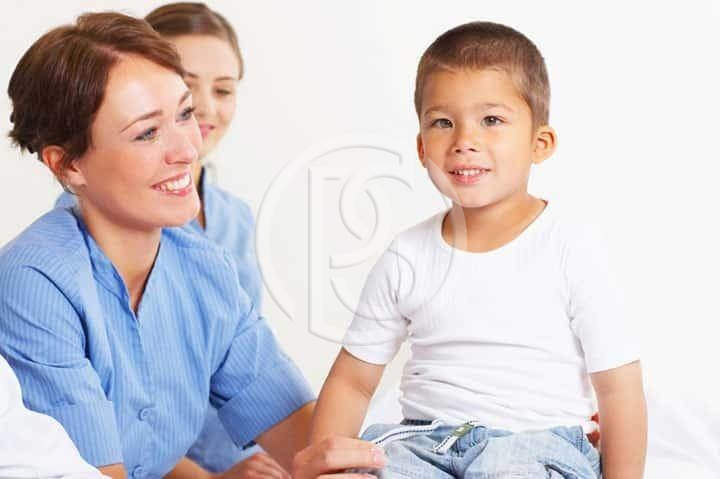
Treatment of dementia in children is a long process that requires an integrated approach and organization not only from doctors, but also from parents. The main emphasis is on eliminating the disease that causes dementia. The treatment program is developed taking into account the stage of the disease and the condition of the patient. After diagnosing the disease, a set of methods and techniques is usually used, including the following:
Drug treatment. The doctor prescribes medications aimed at improving the metabolism of nerve cells in the brain and increasing blood flow. Psychostimulants and nootropics help improve mental abilities without compromising the child’s health.
Psychological aspect. Correctional classes are conducted by experienced psychologists with the aim of developing thinking abilities, memory and attention. The program takes into account the degree of development of dementia in children, on the basis of which the level of educational load is selected.
Unfortunately, dementia cannot be fully cured. Modern medicine can only slow down its course, so timely diagnosis and professional examination are very important here, which helps prevent the rapid progression of the disease and improve the quality of life.

Dementia in children and adolescents is a deep irreversible mental disorder associated with the decay of intelligence, impaired cognitive processes and impoverishment of the emotional sphere as a whole.
To identify mental retardation, psychological testing, laboratory and instrumental studies are used.
This condition cannot be treated, so symptomatic treatment is used for children suffering from decreased intelligence.
Dementia treatment
For the correct and most effective treatment, it is important to recognize the symptoms of mental retardation as early as possible and determine the severity of the disease; you should also find out the cause of its occurrence.
Daily monitoring of the baby’s behavior is important; psychologists conduct special tests, and various innovative methods are used to determine the degree of mental disorder. Only after this is treatment prescribed, aimed at reducing the manifestations of the disease, teaching the little man certain actions that will help him lead an independent life in the future.
The principles of non-drug treatment are as follows:
- Psychological support for a sick child, holding a close conversation with him. Under no circumstances should he be isolated from society and communication. Isolation leads to even more serious negative consequences.
- Placing him in a special school, where he can learn to live independently and acquire some knowledge and skills. Education allows you to develop imagination, thinking and imagination, and helps you begin to interact with peers and adults.
- The ability of parents to listen to the wishes of their child and express their thoughts so that he understands them.
Tranquilizers, antipsychotics and other drugs that have a calming effect on the patient are sometimes used as drug treatment. Such funds are no longer aimed at treatment, but at eliminating obvious signs of a mental disorder.
For such children, psychological help from their parents is important.
Often people with dementia are in psychiatric clinics only because their relatives got scared and abandoned them when they were just children. On the one hand, such parents can be understood, but on the other hand, this is their child, and it doesn’t matter what disease he suffers from, it is important to help him cope with the problem and adapt to this world.
We looked at the main signs of dementia in children, as well as methods of treating the disease. This is a serious disorder that can cause a lot of inconvenience for both children with this diagnosis and their parents, but the sooner mental retardation is diagnosed, the better its treatment will proceed.
Childhood dementia is a disease characterized by a decline in intelligence (dementia). Most often in children, this disease begins to manifest itself by the age of two or three years (up to 2 years, as a rule, development occurs according to age).
Prevalence of the disease and its causes
Dementia occurs not only in older people, but also in children. According to medical statistics, the level of childhood dementia in Russia is 1.64%.
For comparison: in Canada this figure is 1.12%, in Finland 1.19%, in the USA 1.2%, in Australia 1.43%, in China 1.71%.

Childhood dementia can be congenital or acquired. Its main reasons are:
- infectious diseases suffered by a woman during pregnancy;
- premature birth;
- asphyxia and injuries received during childbirth;
- social and pedagogical neglect at an early age;
- genetic diseases;
- traumatic brain injuries, bruises and concussions;
- encephalitis, meningitis, human immunodeficiency virus (HIV);
- disturbance of vascular blood flow and insufficient nutrition of brain tissue.
It is not always possible to establish the root cause of dementia in children and adolescents.
Solving this complex problem requires the help of qualified specialists and comprehensive diagnostics of the whole organism.
Types and forms
ICD-10 identifies four degrees of mental retardation in children and adolescents: mild, moderate, severe and profound.
In accordance with this classification, classical psychiatry distinguishes four degrees of dementia: debility, mild imbecility, severe imbecility and idiocy.
Types of dementia in children and adolescents:
IQ level
Degree of mental retardation according to ICD-10
Classification in classical psychiatry
Mental age, years
Imbecility is not pronounced
- Morons. Able to carry out simple buildings with guidance. Their speech and motor functions are slightly impaired, so they experience difficulties when communicating with peers.
- Imbeciles. They are not adapted to independent life. They are trained in defectological institutions. Over time, they learn to perform simple tasks.
- Idiots. Not trainable. Sometimes they have the rudiments of speech. Eating, dressing, and performing hygiene procedures can only be done with the help and under the supervision of outsiders.
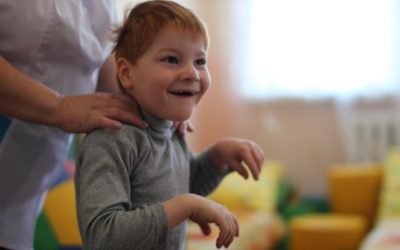
Dementia in children and adolescents can be residual organic or progressive:
- The residual organic form is caused by residual brain damage as a result of traumatic brain injury, meningitis, and drug poisoning of the nervous system. This form of dementia does not progress and is stable, without further worsening of symptoms.
- Progressive dementia develops due to vascular lesions of the brain, genetic diseases and diseases of the spinal cord. This form is characterized by a gradual increase in symptoms of dementia.
Degrees of dementia and symptoms
To thoroughly understand the symptoms of dementia in children, you need to look at the degrees of mental retardation and their classification:
- Mild retardation or debility, when the IQ is 0.50-0.70. In this case, the child is able to carry out simple activities, but he experiences difficulties with memorization and problems in social relationships with other children. Most often, children with this diagnosis are sent to study in special schools, where a special educational program is provided.
- Moderate mental retardation or imbecility. A child can be trained to perform simple tasks and assignments, but such children are not adapted to a completely independent life and require constant attention from an adult.
- Severe mental retardation or idiocy. IQ indicators are at a fairly low level - below 0.20. Such children cannot even dress themselves or eat food on their own, although they have some rudiments of speech. Memory is practically undeveloped, the child is not able to learn anything. The disease is often accompanied by developmental disorders of internal organs and physical disabilities.
To determine the extent of the disease, it is necessary to seek quality medical care. In a hospital setting, an examination is carried out, the patient is under the supervision of specialists for some time, after which a diagnosis is established.
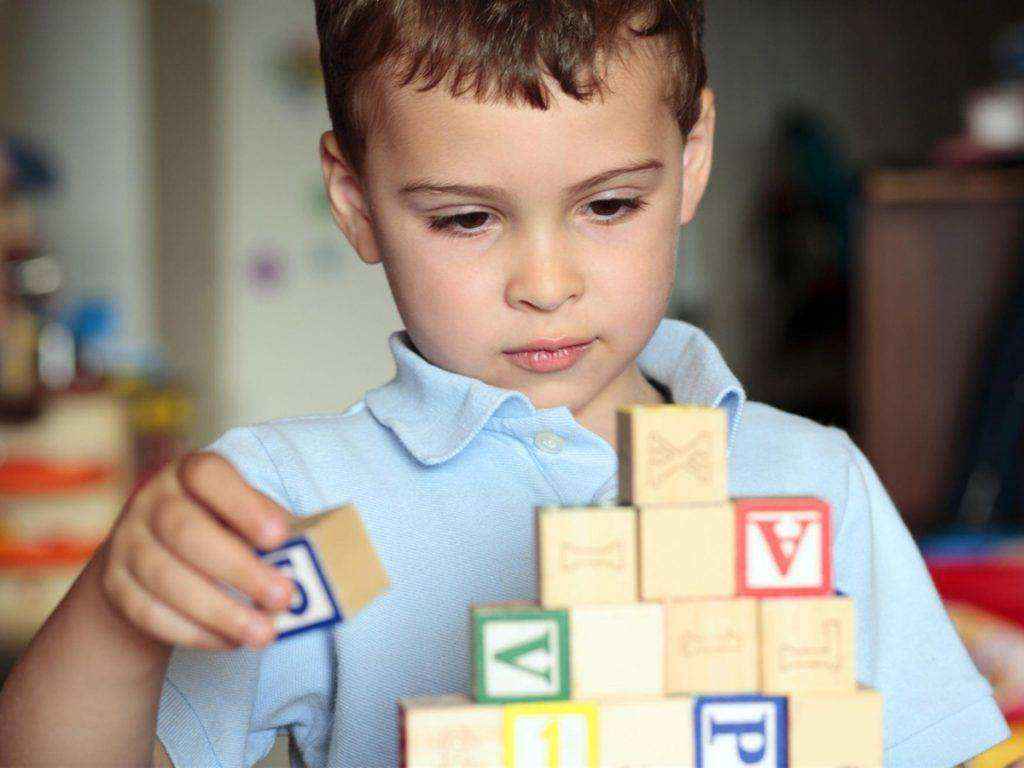
Children with mild retardation experience certain difficulties with remembering and face problems in relationships with peers, but can independently perform some actions
Symptoms of childhood dementia
Symptoms and signs of dementia in children and adolescents vary depending on the underlying cause of the disease and the severity of its progression.
The most common signs of childhood dementia are impaired attention, memory, speech, deviant behavior and fatigue.
The first sign of dementia in young children and preschoolers is the persistent loss of skills that were previously learned and easily practiced.
We can talk about mental retardation if the child:
- later peers begin to walk and talk;
- forgets words, constructs sentences incorrectly;
- looks unkempt, does not care about his appearance;
- feels indifference to the outside world;
- loses affection for loved ones.
The baby's movements become disinhibited, and high spirits prevail. With further development of the disease, the child’s movements become less differentiated and more uniform.
If in preschool age it is quite difficult to recognize mild dementia, then during school years the disease manifests itself more confidently:
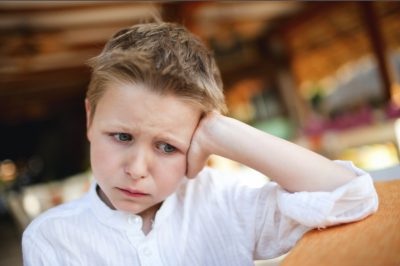
- the student has difficulty learning new material;
- writes and reads slowly, cannot solve logic problems;
- does not understand the meaning of proverbs and sayings;
- cannot reproduce the content of the text just read;
- forgets words, has difficulty constructing sentences;
- reacts inappropriately to the words and actions of others;
- gets tired quickly, often feels apathy and lethargy.
- the child does not assimilate social and legal norms;
- does not take care of himself, looks untidy;
- loses interest in hobbies and previously favorite activities;
- begins to obsessively collect unnecessary things;
- all his games become monotonous, with constantly repeating actions;
- does not remember information well, thinks superficially, and has problems doing homework.
Previously acquired skills and speech are retained for a long time, but memory works selectively. For example, a preschooler can name the days of the week and the sequence of seasons in order, but confuse the colors.
What are the symptoms of dementia at 15? At this age, dementia can be recognized by the following signs:
Symptoms of dementia indirectly depend on the child’s temperament, his state of health, the presence of concomitant diseases, the social and everyday aspects of his life and some other factors.
About the symptoms of mental retardation in this video:
Signs of dementia in children: symptoms of childhood dementia in preschoolers and adolescents aged 11-15 years
Dementia in children and adolescents is a deep irreversible mental disorder associated with the decay of intelligence, impaired cognitive processes and impoverishment of the emotional sphere as a whole.
To identify mental retardation, psychological testing, laboratory and instrumental studies are used.
This condition cannot be treated, so symptomatic treatment is used for children suffering from decreased intelligence.
Causes of mental retardation in children
Once a deviation is identified, doctors prescribe a comprehensive examination of the patient to determine the cause of mental retardation.
It is not always possible to identify the provoking factor; in addition, in some cases the simultaneous presence of several causes is revealed.
Depending on their type and origin, there are two large groups of factors that can provoke mental retardation in a child:
- external, exogenous;
- internal, endogenous.
Endogenous causes of mental retardation
Among the main endogenous factors causing mental retardation, the following reasons are distinguished:
- Heredity.
Congenital dementia in 75% of cases is the result of genetic abnormalities. Thus, a hereditary factor can manifest itself in the incompatibility of the Rh factor in the mother and the unborn child, chromosomal diseases (Down syndrome). - Protein metabolism disorder
- phenylketonuria is accompanied by impaired mental activity. - Inflammatory processes in the brain and its membranes
- meningitis, meningoencephalitis, which occur in a baby, cause mental retardation. - Birth injuries
- compression of the skull, hypoxia can cause disturbances in the development of the brain, which is expressed in mental retardation.
Exogenous causes of mental retardation
Mental retardation has been studied by scientists as a disease for a long time. As a result, a number of exogenous factors that can provoke acquired dementia were identified. Among the main ones:
- Infectious diseases of the mother during pregnancy (rubella, viral hepatitis, measles).
- Intoxication of the maternal body during pregnancy is any condition of the maternal body that occurs under the influence of toxic substances: long-term use of medications, alcohol.
- Dystrophies of a pregnant woman are metabolic disorders in tissues that cause disruptions in their functioning.
- Infection of the fetus with parasites from the mother's body (toxoplasmosis).
- Syphilis in the mother can provoke infection with a spirochete, which damages the fetal brain.
- Injuries to the fetus during childbirth - application of forceps, compression of the fetal head during prolonged labor.
- Prolonged fetal asphyxia during childbirth.
- Environmental factors – the term digital dementia is being heard more and more often. Modern children do not strive for learning, knowledge and acquiring new skills.
Diagnostics
When the first signs of dementia appear, the child should be shown to a qualified neurologist, who will assess the neuropsychic state of the young patient and take a history of his illness.
Upon referral from a neurologist, the child will have to undergo testing in a psychologist’s office, as well as laboratory and instrumental examination.
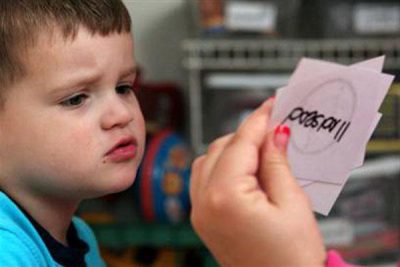
To identify mental retardation, the following types of psychological tests are used:
- Eysenck test - shows the mental age and intelligence quotient (IQ) of the patient.
- Stanford-Binet Intelligence Scale - assesses the mental development of children aged 6 to 16 years.
- The Wechsler test assesses the intelligence of children aged 2.5 to 7.5 years.
- Benton's visual retention test - identifies organic brain damage and its severity.
If dementia is suspected, the child is prescribed a laboratory blood test for glucose, thyroid hormones, vitamin B12, syphilis, ALT and AST.
A general blood test can detect the presence of infectious processes in the body, and a biochemical screening can be used to assess the functional state of the kidneys and the level of electrolytes in the blood.
The doctor may order genetic testing to detect Down syndrome, DiGeorge syndrome, Lejeune syndrome (cry of the cat), and fragile X chromosome.
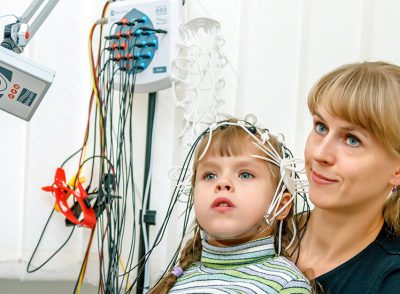
Fluctuations in alpha, theta and delta waves indicate acquired dementia syndrome and delayed psychomotor development in a child.
Dementia in children and adults: what is this disease, causes, symptoms and treatment
Dementia in children and young people is an acquired dementia, which is accompanied by the loss of already developed intelligence.
With this disease, brain tissue is damaged, as a result of which memory, speech, analytical and cognitive abilities, and motor skills are impaired. It is customary to talk about acquired dementia in children when the child reaches 2-3 years of age, when behavior can reveal noticeable deviations from normal mental development.
Overt, progressive dementia is most often observed in children after 15 years of age, when the biological maturation of the brain ends.
Types of mental retardation
The term “mental retardation” in children is usually used to designate a group of hereditary, congenital or acquired at an early age disorders of general mental development. This condition is characterized by impaired abilities that manifest themselves during the period of personality maturation. At the same time, general intelligence, speech, motor and social abilities suffer.
The degree of severity and depth of the intellectual defect is used as a differentiating factor when constructing a classification of mental retardation. Depending on this, the following degrees of dementia are distinguished:
General
Dementia is an acquired dementia. It occurs not only in adults, but also in children. To correctly understand the terminology, it is necessary to distinguish between some concepts:
- Children under three years of age are not diagnosed with childhood dementia. In this case, “mental retardation” or “oligophrenia” is indicated.
- After three years, “childhood dementia” is also not diagnosed. In this case, the correct terminology is organic lesion in children.
The clinical picture of organic damage itself is similar to the symptoms of organic dementia. At what age does dementia begin - from the moment the pathological factor affects the brain.
Causes
Dementia at an early age occurs due to the following reasons:
- Neuroinfections affecting brain tissue: encephalitis, meningitis, meningoencephalitis, arachnoiditis.
- Traumatic brain injuries that damage the substance of the brain.
- Chronic intoxication, such as drug intoxication or frequent administration of anesthesia. In adolescent children, intoxication may occur due to the use of alcohol or drugs.
All of these causes develop degenerative changes in the cortex and subcortical structures of the brain. Due to neurodegeneration, the child’s cognitive properties are weakened.
Often childhood dementia acts as a residual organic dementia. The term "residual" means "residual." This means that the lack of intelligence occurs as a result of past pathological conditions.
Acquired dementia in children is classified by cause. For example, a child has an accident. As a result of the blow, the left hemisphere was damaged, causing an intellectual defect. In this case, a diagnosis of “traumatic organic brain damage in a child” is made. If it is a neuroinfection – “infectious organic lesion”.
At-risk groups
Every person (young and middle-aged) has a fairly high risk of contracting this terrible disease.
The following factors pose a serious threat:
- smoking;
- excessive alcohol consumption;
- high cholesterol;
- obesity;
- severe depression;
- atherosclerosis;
- diabetes;
- hypertension or hypotension;
- high levels of estrogen and homocysteine in the blood.
Any of these factors can lead to early dementia, so it is necessary to take all tests in advance and change your usual lifestyle. Array
Diagnostics
When the first signs of dementia appear, the child should be shown to a qualified neurologist, who will assess the neuropsychic state of the young patient and take a history of his illness.
Upon referral from a neurologist, the child will have to undergo testing in a psychologist’s office, as well as laboratory and instrumental examination.
Psychological testing
To identify mental retardation, the following types of psychological tests are used:
- Eysenck test - shows the mental age and intelligence quotient (IQ) of the patient.
- Stanford-Binet Intelligence Scale - assesses the mental development of children aged 6 to 16 years.
- The Wechsler test assesses the intelligence of children aged 2.5 to 7.5 years.
- Benton's visual retention test - identifies organic brain damage and its severity.
Laboratory research
If dementia is suspected, the child is prescribed a laboratory blood test for glucose, thyroid hormones, vitamin B12, syphilis, ALT and AST.
Source: https://cosmeton.ru/deti/priznaki-slaboumiya-u-detej.html
Treatment tactics
Symptomatic therapy can prevent further weakening of intelligence and maintain its existing level.
For the symptomatic treatment of dementia, antipsychotics, anticonvulsants, tonics, vitamins and biogenic stimulants are used.
If a small patient suffers from tension, aggression, a pronounced feeling of fear, mental disinhibition, mood swings, apathy, lethargy or poor sleep, he is prescribed antipsychotics Azaleptin, Clozapine, Nootropil, Noocetam, Olanzapine, Piracetam, Reserpine, Cerebrolysin, etc.
For convulsions, the child is prescribed anticonvulsants, which reduce hyperkinesis, contribute to partial compensation of personality disorders and reduce emotional tension.
In parallel, children are prescribed diuretics, complexes of vitamins and microelements, as well as medications that reduce intracranial pressure.
The program for the treatment of dementia in children includes biogenic stimulants Actovegin, Cortexin, Mexidol, Albumin, Apilak, etc.
The listed drugs stimulate cellular metabolism due to the accumulation of oxygen and glucose in the brain tissue.
B vitamins stop the processes of excitation of the nervous system, help improve memory and increase concentration.
The intake of B vitamins should be supplemented with iodine-containing products, amino acids and hormonal drugs.
- symptoms and treatment in older people;
- reasons for the development of dementia at an early age;
- connections between dementia and other diseases;
- differences in manifestations between men and women;
- about how relatives should behave with a sick person and whether he needs nursing care;
- Is it possible to prevent the disease and what does it consist of?
Some sad facts about dementia
Science has established the following facts about dementia:
- The disease is hereditary. If someone in the family had such a diagnosis, then there is a very high probability that in old age it will manifest itself in one of the descendants.
- Early symptoms of dementia can appear at a young age. If such signs appear, you should definitely consult a doctor for treatment. Otherwise, a person may experience severe emotional shock, and sharp premature aging of the whole organism will begin.
- The speed of development of the disease varies from person to person. But doctors note that people living in families show less aggression than people living alone.
- Dementia occurs twice as often in older women as in men.
- Drug addiction and alcoholism can trigger the onset of dementia at an early age.
- If you notice the first symptoms of dementia in the elderly, you should consult a doctor for treatment. This is a rapidly progressing disease. If correction is not prescribed, the patient’s aggressive behavior can become dangerous to others.
Psychological help
Psychological help is needed both for mentally retarded children and for the relatives who look after them and are constantly nearby.
Types of psychological assistance for dementia:
Help for mentally retarded children and adolescents
Help for relatives of mentally retarded children and adolescents
- constant encouragement, instilling hope, praise, empathy;
- training, encouragement, explanation and advice;
- solving everyday problems
- alternating nursing and rest schedules;
- regular change of environment;
- abstracting from the problems of a sick child and switching attention to positive things
It is important to treat a mentally retarded child as a person, and not as a problem, to reinforce his ability to cope with the vicissitudes of fate and everyday difficulties, to emphasize positive qualities and achievements, to maintain a sense of self-confidence, and to promptly prevent relapse of the disease.
About raising children with mental retardation in this video:
